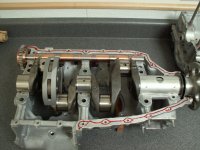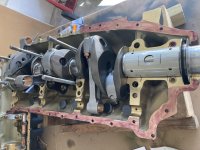Due to cam issues I am having to take apart my RV3’s 0235 CI engine. Has anyone had any experience using Loctite 515 (which Lycoming lists as alternative) to seal case half’s instead of silk thread? Also is it recommended or advisable to use some type of sealant on the sump and accessory case gaskets?
Van's Air Force
You are using an out of date browser. It may not display this or other websites correctly.
You should upgrade or use an alternative browser.
You should upgrade or use an alternative browser.
Lycoming gaskets and sealants
- Thread starter navy06
- Start date
ultimate10201
Member
Used the Loctite 515 method on the case halves when I rebuilt my IO-360-A1B last summer/fall. Used a carefully applied thin layer to one case half per the instructions to avoid excess ‘squeeze-out’.
I used Permatex Form-A-Gasket on the sump and accessory case gaskets, again avoiding excess.
No leaks after 57 hours.
I used Permatex Form-A-Gasket on the sump and accessory case gaskets, again avoiding excess.
No leaks after 57 hours.
hgerhardt
Well Known Member
I used Loctite 518 on my crankcase flanges 15 years and 900 hours ago and so far still leak-free. According to Henkel, 518 is better suited to aluminum flanges so that's what I used instead of 515.
The nice thing about anaerobic sealants is the squeeze-out will NEVER harden, so whatever you can't reach will dissolve into the oil and get carried out with 1st oil change.
Also, my suggestion is to use a 1/8" dia bead and NOT smooth it out. That way you won't trap air bubbles like you might in a varying thin layer of the stuff. This is how factories do it with their automated dispensing robots. Below is what the bead looked like before I assembled the case halves.

The nice thing about anaerobic sealants is the squeeze-out will NEVER harden, so whatever you can't reach will dissolve into the oil and get carried out with 1st oil change.
Also, my suggestion is to use a 1/8" dia bead and NOT smooth it out. That way you won't trap air bubbles like you might in a varying thin layer of the stuff. This is how factories do it with their automated dispensing robots. Below is what the bead looked like before I assembled the case halves.

[email protected]
Well Known Member
I realize you are just now going to put the engine back together. But, let it be noted that if you use silicone valve cover gaskets. They will bleed silicone into the oil giving the oil analysis people a higher reading of silicone in the oil. leaving them to think you are ingesting dirt.
Some time ago I sent a bottle of oil from an oil change and got an alert of a possible intake leak. Thought it was weird and called and after some questions we realized I had just replaced the valve cover gaskets with new silicone ones.
Blackstone said, Well now, there is your intake leak. ha ha ha.
No leak, But, silicone came down on the next oil change.
Yes I still have silicone gaskets.
Enjoy the ride Art
Some time ago I sent a bottle of oil from an oil change and got an alert of a possible intake leak. Thought it was weird and called and after some questions we realized I had just replaced the valve cover gaskets with new silicone ones.
Blackstone said, Well now, there is your intake leak. ha ha ha.
No leak, But, silicone came down on the next oil change.
Yes I still have silicone gaskets.
Enjoy the ride Art
hgerhardt
Well Known Member
Would permatex aviation gasket sealer be good for the sump and accessory case gaskets? It’s non hardening and easy to apply with the brush that comes with it. I would coat gasket lightly in both sides.
I used to use the Permatex aviation form-a-gasket religiously on fiber/paper gaskets but stopped about 20 years ago and just install them dry now. Same results either way for me.
One thing I do however is to put a tiny dab of RTV wherever another gasket intersects, like the sump where the accessory case joints intersect, and at the crankcase parting line at the top where the accessory case touches.
Also, in the case of the accessory housing gasket, install that first (before the sump). Then take a razor blade and shave off whatever part of the gasket is proud of the joint so that there is a nice flat surface for the sump gasket to seal against.
Last edited:





